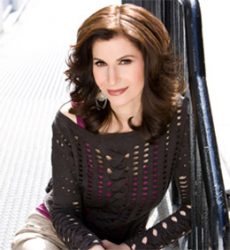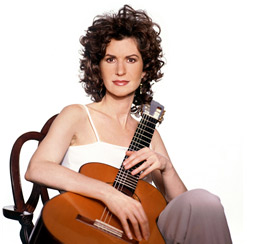Sharon Isbin is considered the leading classical guitarist of our time. Among her many honors, she was named “Best Classical Guitarist” by Guitar Player magazine, and is the first guitarist in over 40 years to receive two classical GRAMMY Awards, in 2001 and 2010.
Isbin is a former student of Andrés Segovia, a graduate of Yale University, and is head of the guitar department at the Aspen Music Festival and The Juilliard School. She has performed to sold-out audiences around the world—from Carnegie Hall to London’s Barbican to the White House.
Linda Egenes: What do you feel has made your music stand out from the crowd?
Sharon Isbin: I explore a variety of genres, from my home base in classical to unusual collaborations in jazz, bossa nova, folk, country, rock, and even film music, performing on Scorsese’s The Departed. But most important to me and to listeners is the emotion, lyricism, sensuality, and passion.
 Linda Egenes: What is your process of interpreting the music that you play?
Linda Egenes: What is your process of interpreting the music that you play?
Sharon Isbin: I choose music that I love and which speaks to me, and that makes it easy to be expressive. The more I play a new work, the more I discover in it. My goal is to enter the mind of the composer while feeling and expressing the emotion from within.
In a way, I explore different characters of a piece much like actors do with a script. And when I choose dynamics and shadings to delineate the different layers and levels of voicing, architecture, and structure within a work, it’s much like a director staging and guiding actors in the foreground, middle, background, etc.
Linda Egenes: Do you feel different when you perform a piece by Joan Baez versus a classical piece? Is the creative process any different?
Sharon Isbin: Though I explore a different kind of rhythmic and stylistic freedom when playing with Joan Baez or Steve Vai than I do playing Bach—though Bach’s music, with all its improvised ornaments and embellishments, was the jazz of its time—my goal is always to make the music sound fresh, imaginative, and heartfelt.
“TM enhances my mental stamina, memory, concentration, and ability to learn. It puts me in touch with my innermost creative core and enables its expression through music.” —Sharon Isbin
Linda Egenes: You have been called “the Monet of classical guitar—a master colorist.” Why do you think people have such an emotional reaction to your music?
Sharon Isbin: I love to be expressive on the guitar with lyricism, dynamic contrasts, nuances, phrasing, articulation, and a panoply of colors and timbres. I cultivate these techniques to serve the music and to communicate it with feeling and emotion.
For example, I can make the guitar sound like a human voice by connecting notes of a melody with nuances of sound while shaping the contour of the line as a vocalist would do. This also creates a three-dimensional quality and depth.
Linda Egenes: You’ve written a teaching guitar book. Are there techniques you’ve developed and are passing on to your students?
Sharon Isbin: Among the topics I explore with my students at Juilliard and in my Classical Guitar Answer Book are techniques I’ve developed of preparation, memorization, and visualization to encourage peak performance. These are the secrets and methods I’ve discovered and refined over years of performing which I am able to share with others.
I find it particularly effective to practice these techniques after a session of meditation when my mind is especially stress-free and receptive to suggestions and learning. The end of a meditation is an ideal time, in fact, to plant any suggestion about a goal or task you wish to achieve.
“When I perform, I enter a state very similar to the one I enter when practicing TM—a sense of communion with the energy of the universe, the audience, the composer, and the music.” —Sharon Isbin
 Linda Egenes: You have been practicing the TM technique since you were 17. Do you feel that transcending on a regular basis has had an influence on your artistry and work?
Linda Egenes: You have been practicing the TM technique since you were 17. Do you feel that transcending on a regular basis has had an influence on your artistry and work?
Sharon Isbin: Practicing TM has inspired heights of creativity for me on many levels: as a musician, arranger, educator, writer, and artistic director. Because TM is so effective at eliminating stress and distraction, it encourages laser-sharp focus and concentration for any task.
As a musician, TM enhances my mental stamina, memory, concentration, and ability to learn. It puts me in touch with my innermost creative core and enables its expression through music. Most importantly, it facilitates instant access to a state of “cosmic immersion,” that feeling of being in the flow, or “in the zone.”
When I perform onstage, I enter a state of being very similar to the one I enter daily when practicing TM. It’s a sense of communion with the energy of the universe, the audience, the composer, and the music—without ego or interference. It’s a feeling of unity between me and the listeners, a sense of oneness in which we are all experiencing the beauty of the music together.
That sensation is one of the reasons live performances can be so powerful—everyone is focused and transported, and the experience is unique and in the moment, never to be replicated.


Comments
You May Also Like
Creativity & the Arts
Taking the Leap from Ballet to Broadway
A fifteen-year-old from Salt Lake City gets accepted for the School of American Ballet, graduates, joins the NYC Ballet at eighteen, becomes a soloist by nineteen, and a principal dancer by twenty.
Creativity & the Arts
Lawrence Sheaff: An Artist Giving Back
Lawrence Sheaff worked with Maharishi Mahesh Yogi as a visual artist for 18 years. When he returned to his own work he wanted to combine the two things he loved most: Vedic Science and painting.
Creativity & the Arts
Jerry Seinfeld Talks Transcendental Meditation (TM) with Bob Roth | 60:00
With TM® "it’s like you have a cell phone, and then somebody gives you the charger. And you go, 'Oh. Now I can get this thing up to a hundred any time I want.' ” —Jerry Seinfeld
Personal Growth
Paul Horn and the Music of Meditation
"Music is organized sound. Sound is the basis of creation. The whole universe is comprised of sound. Music is the vehicle through which you travel as a musician." —Paul Horn